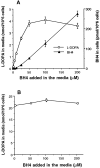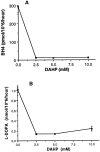Double transduction with GTP cyclohydrolase I and tyrosine hydroxylase is necessary for spontaneous synthesis of L-DOPA by primary fibroblasts
- PMID: 8699255
- PMCID: PMC6578851
- DOI: 10.1523/JNEUROSCI.16-14-04449.1996
Double transduction with GTP cyclohydrolase I and tyrosine hydroxylase is necessary for spontaneous synthesis of L-DOPA by primary fibroblasts
Abstract
Gene transfer of tyrosine hydroxylase (TH) in animal models of Parkinson's disease (PD), using either genetically modified cells or recombinant virus vectors, has produced partial restoration of behavioral and biochemical deficits. The limited success of this approach may be related to the availability of the cofactor, tetrahydrobiopterin (BH4), because neither the dopamine-depleted striatum nor the cells used for gene transfer possess a sufficient amount of BH4 to support TH activity. To determine the role of BH4 in gene therapy, fibroblast cells transduced with the gene for TH were additionally modified with the gene for GTP cyclohydrolase l; an enzyme critical for BH4 synthesis. In contrast to cells transduced with only TH, doubly transduced fibroblasts spontaneously produced both BH4 and 3, 4-dihydroxy-L-phenylalanine. To examine further the importance of GTP cyclohydrolase I in gene therapy for PD, in vivo micro-dialysis was used to assess the biochemical changes in the dopamine-denervated striatum containing grafts of genetically modified fibroblasts. Only denervated striata grafted with fibro-blasts possessing both TH and GTP cyclohydrolase I genes displayed biochemical restoration. However, no significant differences from controls were observed in apomorphine-induced rotation. This is partly attributable to a limited duration of gene expression in vivo. These differences between fibroblasts transduced with TH alone and those additionally modified with the GTP cyclohydrolase I gene indicate that BH4 is critical for biochemical restoration in a rat model of PD and that GTP cyclohydrolase I is sufficient for production of BH4.
Figures








References
-
- Anton R, Kordower JH, Maidment NT, Manaster JS, Kane DJ, Rabizadeh S, Schueller SB, Yang J, Edwards RH, Markham CH, Bredesen DE. Neural-targeted gene therapy for rodent and primate hemiparkinsonism. Exp Neurol. 1994;127:207–218. - PubMed
-
- Barker R, Dunnett SB. Ibotenic acid lesions of the striatum reduce drug-induced rotation in the 6-hydroxydopamine-lesioned rat. Exp Brain Res. 1994;101:365–374. - PubMed
-
- Carlsson A, Davis JN, Kehr W, Lindqvist M, Atack CV. Simultaneous measurement of tyrosine and tryptophan hydroxylase activities in brain in vivo using an inhibitor of the aromatic amino acid decarboxylase. Naunyn Schmiedebergs Arch Pharmacol. 1972;275:153–168. - PubMed
Publication types
MeSH terms
Substances
Grants and funding
LinkOut - more resources
Full Text Sources
Other Literature Sources
